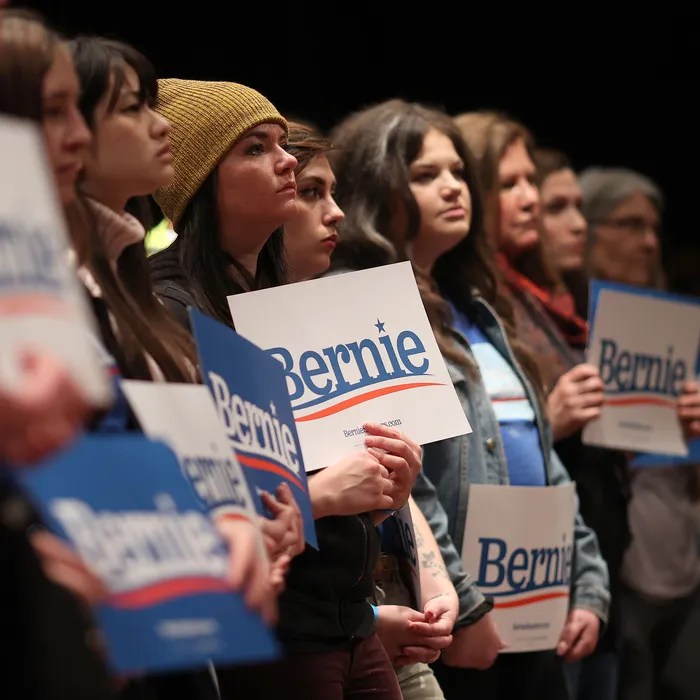
Not him, them.
Photo: Win McNamee/Getty Images
A specter is haunting centrist Democrats — the specter of a Bernie Sanders nomination. As the democratic socialist has taken the lead in Iowa and New Hampshire, and narrowed Joe Biden’s advantage in national polls, the high clerics of Clintonism have begun calling for a (political) counterrevolution.
“People need to start taking Bernie pretty seriously — there is a really substantial risk of him becoming unstoppable if he wins these early states by large numbers,” Matt Bennett, vice-president of the centrist think tank Third Way, told the Washington Post this week. Bennett went on to chastise his fellow moderates for getting anxious instead of organized, lamenting, “It’s not like our phone is ringing from people saying, ‘Let’s do something.’ ”
Third Way has been flooding influential Iowa Democrats’ in-boxes with memos on Sanders’s general-election liabilities and seeding similar stories in the mainstream press. Meanwhile, the Democratic Majority for Israel super-PAC is warning Iowans that a vote for a septuagenarian socialist with a heart condition is, in effect, a vote for four more years of President Trump. But a broad-based, deep-pocketed “Anyone But Sanders” push has yet to take shape. Allies of Michael Bloomberg have indicated that the billionaire’s burgeoning campaign will transform itself into such an entity, if necessary. If Biden suffers damage in the early states, the last thing he’ll need is for Bloomberg, an alternative anti-left candidate, to ramp up his (already gargantuan) ad spending, and likely eat into Uncle Joe’s margins on Super Tuesday. But by the time Iowa and New Hampshire are in the books, it may already be too late (after all, had the GOP Establishment’s interventions against Trump been less belated, our republic might not be in its present mess). Thus, for Third Way and its fellow tribunes of triangulation, the time to act is now: The Democratic Establishment stands at the crossroads — it can either transition to anti-Sanderism or acquiesce to four more years of barbarism.
But they’re wrong, and not merely because their assessment of Sanders’s general-election viability is tendentious and undermined by current polling. Even if one accepts Third Way’s memo as gospel, the hazards of mounting a massive “Anyone But Sanders” campaign still outweigh the benefits.
The reason for this is simple: Democrats will need high turnout among young, left-leaning voters in November, and Bernie Sanders is overwhelmingly popular with such voters.
The age gap between the support bases of the two leading Democratic candidates is unprecedented in scale. According to a Quinnipiac poll released Wednesday, Bernie Sanders boasts the support of 53 percent of Democratic voters under 35 nationwide, while Joe Biden lays claim to just 3 percent. That poll’s margin of error is 3.4 percentage points — which means that the percentage of younger voters who support the Democratic Party’s current front-runner could, technically, round down to zero. In other national surveys, age polarization among Democratic primary voters tends to be a bit less severe. But in virtually all of them, Biden’s support among the young is historically low for a front-running candidate, while Sanders’s popularity with the contingent is exceptionally high.
It will be hard enough for Biden to mobilize younger voters after beating Sanders in a relatively friendly primary fight, free of conspicuous interference from Establishment forces. If Uncle Joe has to win millennial and Gen-Z hearts and minds — after riding to the nomination on the back of a wall-to-wall anti-Bernie ad blitz from Third Way and friends — his task may be impossible. Although Sanders’s 2016 backers did not sit out (or defect) during the general election in aberrantly high numbers, the age gap between Biden and Bernie backers this year is even larger than the one that prevailed between Clinton and the Vermont senator four years ago. One recent Emerson College poll found that only 53 percent of Sanders’s current supporters plan to vote for the Democratic nominee in November, no matter who that person turns out to be. There’s some reason to consider that survey an unreliable outlier. Previous surveys have suggested that “Bernie or Bust” is a very marginal tendency among Democratic primary voters. But disaffected younger voters don’t need to withhold their votes in principled protest to cost Democrats the election: If the Democratic nominee ends up looking like a walking, talking embodiment of Gen-Z’s political disempowerment, a critical mass of younger voters may simply allow life’s quotidian demands to derail their voting plans come Election Day.
Given all this, if the Democratic Party’s incumbent elites united to take down the (supposedly) unelectable socialist, they would risk rendering Biden unelectable in the process, and there’s little rational basis for them to take such a gamble. Yes, Sanders has become a real contender in recent weeks, but Biden is still the front-runner. And the available polling suggests that if this race ever becomes a two-man contest between the leading septuagenarians, the former vice-president won’t have much trouble assembling a plurality of delegates. As is, Biden’s polling advantage in states throughout the South dwarfs the one that Sanders has established in Iowa and New Hampshire.
In these circumstances, it would be irrational for centrist Democrats to launch an “Anyone But Bernie” campaign — unless they include Donald Trump in the “Anyone” category.
Millennials Have Formed a Human Shield Around Bernie Sanders

2 thoughts on “The Bernie Campaign Is Fortified by a Human Shield of Millennials”
Comments are closed.